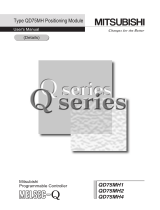
A - 6
REVISIONS
*
The manual number is given on the bottom left of the back cover.
Print Date * Manual Number Revision
Apr., 1998 IB (NA)-66824-A First printing
Apr., 2003 IB (NA)-66824-B Complete review
Oct., 2003 IB (NA)-66824-C Complete review
Feb.,2004 IB (NA)-66824-D
Partial correction addition
CONTENTS, Section 3.5, Section 5.6.2, Section 7.1.2, Section 8.2.5,
Section 8.2.6, Section 10.1.2, Section 10.3.3 to Section 10.3.5,
Section 10.3.8, Appendix 13, INDEX
Jun., 2005 IB (NA)-66824-E
Partial correction addition
SAFETY INSTRUCTIONS, Generic Terms and Abbreviations,
Section 3.4.2, Section 4.2.2, Section 4.3, Section 4.5.1, Section 4.5.3,
Section 4.8.1, Section 5.1.2, Section 5.2.1, Section 5.3, Section 5.7.2,
Section 6.1.1, Section 6.6.1, Section 6.6.5, Section 8.1.1,
Section 8.2.4 to Section 8.2.8, Section 8.5, Section 9.1.2,
Section 9.15, Section 9.2.6, Section 9.2.8 to Section 9.2.11,
Section 10.3.9, Section 11.3.1, Section 12.2.1, Section 14.4.3,
Section 12.4.4, Section 12.5.1, Section 12.5.2, Section 12.7.1,
Section 12.7.5, Section 12.7.6, Section 13.4, Section 14.2,
Section 14.3, Appendix 5.1, Appendix 11, Appendix 12
Jul., 2006 IB (NA)-66824-F
Partial correction addition
Appendix 7.1, INDEX
Sep., 2007 IB(NA)-66824-G
Partial revisions
Section 5.1.2, Section 5.2.1, Section 5.6.1, Section 5.7.1
Apr., 2015 IB(NA)-66824-H
Addition
CONDITIONS OF USE FOR THE PRODUCT
Partial correction addition
SAFETY PRECAUTIONS, INTRODUCTION, ABOUT MANUALS,
COMPLIANCE WITH EMC AND LOW VOLTAGE DIRECTIVES,
GENERIC TERMS AND ABBREVIATIONS, Section 1.3, 2.3, 2.4, 3.1,
3.2, 3.7.1, 3.7.3, 3.7.4, 4.1.2, 4.1.3, 4.2.1, 4.3, 4.5.1, 4.5.2, 4.8.1,
5.1.1, 5.2.3, 5.3, 5.5, 6.1.1, 6.1.2, 9.1.4, 9.1.5, 9.2.7, 10.1.1, 10.1.2,
10.3.5, 10.3.8, 10.4.1, 10.4.2, 12.3.2, 12.4.3, 12.4.4, 12.5.3, 13.4,
Appendix 1, 2, 3.2, 5.1, 5.2, 5.3, 6.1, 7.1, 8.1, 9.1, 11, 12,
WARRANTY
Japanese Manual Version SH-3654-J
This manual confers no industrial property rights or any rights of any other kind, nor does it confer any patent licenses.
Mitsubishi Electric Corporation cannot be held responsible for any problems involving industrial property rights which
may occur as a result of using the contents noted in this manual.
1998 MITSUBISHI ELECTRIC CORPORATION

























